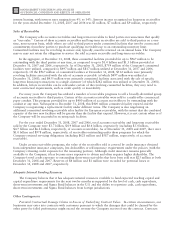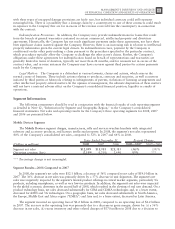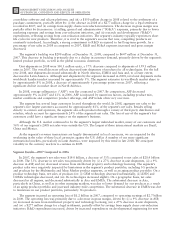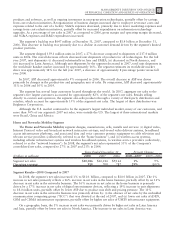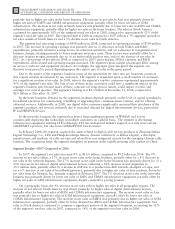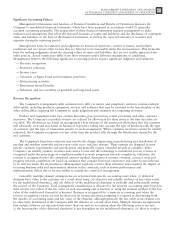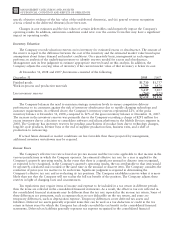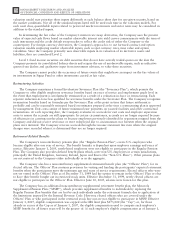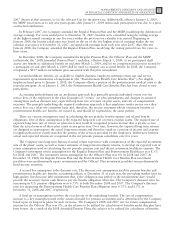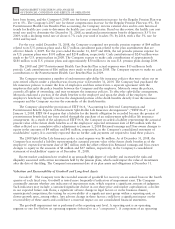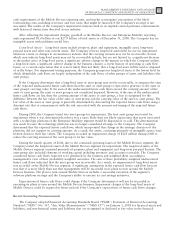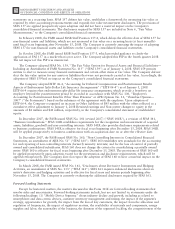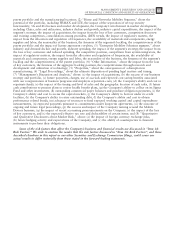Motorola 2008 Annual Report Download - page 75
Download and view the complete annual report
Please find page 75 of the 2008 Motorola annual report below. You can navigate through the pages in the report by either clicking on the pages listed below, or by using the keyword search tool below to find specific information within the annual report.
Significant Accounting Policies
Management’s Discussion and Analysis of Financial Condition and Results of Operations discusses the
Company’s consolidated financial statements, which have been prepared in accordance with U.S. generally
accepted accounting principles. The preparation of these financial statements requires management to make
estimates and assumptions that affect the reported amounts of assets and liabilities and the disclosure of contingent
assets and liabilities at the date of the financial statements, as well as the reported amounts of revenues and
expenses during the reporting period.
Management bases its estimates and judgments on historical experience, current economic and industry
conditions and on various other factors that are believed to be reasonable under the circumstances. This forms the
basis for making judgments about the carrying values of assets and liabilities that are not readily apparent from
other sources. Actual results may differ from these estimates under different assumptions or conditions.
Management believes the following significant accounting policies require significant judgment and estimates:
— Revenue recognition
— Inventory valuation
— Income taxes
— Valuation of Sigma Fund and investment portfolios
— Restructuring activities
— Retirement-related benefits
— Valuation and recoverability of goodwill and long-lived assets
Revenue Recognition
The Company’s arrangements with customers may differ in nature and complexity and may contain multiple
deliverables, including products, equipment, services and software that may be essential to the functionality of the
other deliverables, requiring the Company to make judgments and estimates in recognizing revenues.
Product and equipment sales may contain discounts, price protection, return provisions and other customer
incentives. The Company’s recorded revenues are reduced by allowances for these items at the time the sales are
recorded. The allowances are based on management’s best estimate of the amount of allowances that the customer
will ultimately earn and was based on historical experience taking into account the type of products sold, the type
of customer and the type of transaction specific to each arrangement. Where customer incentives cannot be reliably
estimated, the Company recognizes revenue at the time the product sells through the distribution channel to the
end customer.
The Company’s long-term contracts may involve the design, engineering, manufacturing and installation of
wireless and wireline networks and two-way radio voice and data systems. These systems are designed to meet
specific customer requirements and specifications and generally require extended periods to complete. If the
Company can reliably estimate revenues and contract costs and the technology is considered proven, revenue is
recognized under the percentage of completion method as work progresses towards completion; otherwise, the
revenue is recognized under the completed contract method. Estimates of contract revenues, contract costs and
progress towards completion are based on estimates that consider historical experience and other factors believed
to be relevant under the circumstances. Management regularly reviews these estimates and considers the impact of
recurring business risks and uncertainties inherent in the contracts, such as system performance and
implementation delays due to factors within or outside the control of management.
Generally, multiple element arrangements are separated into specific accounting units when: (i) delivered
elements have value to the customer on a stand-alone basis, (ii) objective and reliable evidence of fair value exists
for the undelivered element(s), and (iii) delivery of the undelivered element(s) is probable and substantially within
the control of the Company. Total arrangement consideration is allocated to the separate accounting units based on
their relative fair values (if the fair value of each accounting unit is known) or using the residual method (if the fair
value of the undelivered element(s) is known). Revenue is recognized for a separate accounting unit when the
revenue recognition criteria are met for that unit. In certain situations, judgment is required in determining both
the number of accounting units and fair value of the elements, although generally the fair value of an element can
be objectively determined if the Company sells the element on a stand-alone basis. Multiple element arrangements
that include software are separated into more than one unit of accounting when the following criteria are met:
(i) the functionality of the delivered element(s) is not dependent on the undelivered element(s), (ii) there is vendor-
67
MANAGEMENT’S DISCUSSION AND ANALYSIS
OF FINANCIAL CONDITION AND RESULTS OF OPERATIONS





